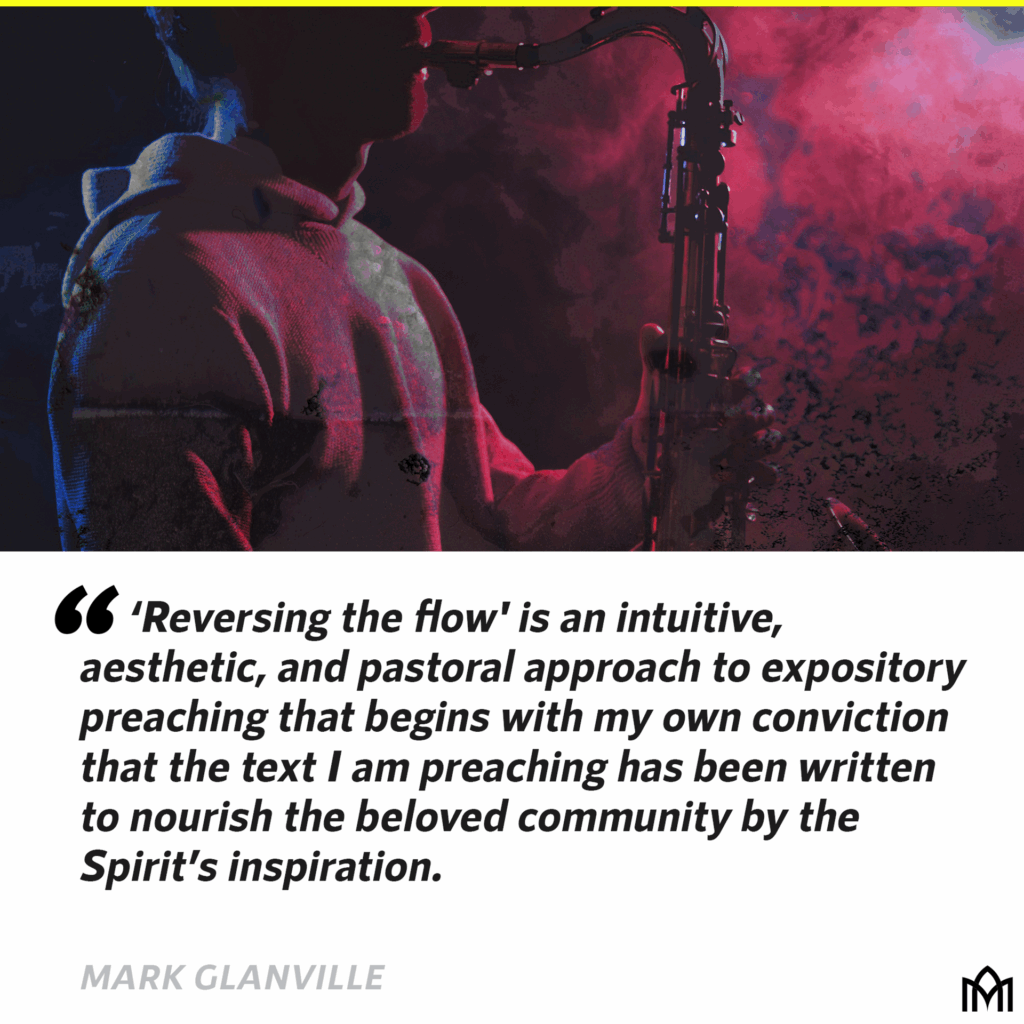Preaching in a New Key: Reversing the Direction of Flow
One damp afternoon during the fall of 2016 I was sharing a pastoral conversation with Kate, a professional artist in her late 20s. Over years of meals and conversations, we had formed a trusting relationship, and the previous year Kate had shared with me her growing doubts in her journey with Christ. “Evangelicalism seems so cold hearted,” she would say. “Why doesn’t the church care about the creation? And about art and artists?” We both knew that our own church cared about these things, but the negligence of the broader church on these issues worried her. In fact, it rocked her faith. This day she told me hesitatingly that she was going to take twelve months off attending church to give herself space to sort out her faith. We are still good friends, but Kate never returned regularly to worship. Kate no longer identifies as Christian.
Kate was experiencing a profound disconnect between her values and the wider church: values around beauty, justice, community, and creation (of course, these values are found throughout Scripture).
This disconnect of values amplified a disconnect that was already there, a baseline of disconnection between Christian faith and her life experience. “What about other religions?” Kate would ask. “How can we presume that we are right and they are wrong?”For Kate, Christianity didn’t resonate at the level of plausibility.
That year though coffees and conversations with dozens of people, I learned to recognize this disconnection of plausibility and values that Kate experienced. I realized that this is the experience of many people who remain in the church, not only young people, but people of all ages, including Boomers. Many people in your church are struggling with doubt, not a doubt that can be solved at a rational level, but a doubt that resides at the level of plausibility and of values.
How do we preach in our cultural context today, where people’s experience of faith is so contested? How can we preach when many of our people don’t assume that Scripture is authoritative? Rather, they have complex relationships with Scripture.
There is a lot to it, to be sure. Our role as preachers is to nourish faith. Nourishing faith today is less about evidence for the resurrection, and more about valuing justice and compassion. Less to do with faith vs science, more about nurturing communitas of hope. One key strategy is what I call “Reversing the direction of flow.” Reversing the direction of flow lies at the heart of my book, Preaching in a New Key: Crafting Expository Sermons in Post-Christian Communities.
Reversing the Direction of Flow in Preaching
For the most part, it isn’t helpful to preach sermons on doubt (though, you may do so with high emotional and relational intuition). Rather, we assume doubt and curiosity and allow that to shape the way that we approach every sermon. The key question is: How can we display the wisdom of Christ and the beauty of Scripture in contexts where these can’t be taken for granted? Be encouraged, we can learn to hold out the Word of Life in a way that is responsive to the complex relationships our people have with Scripture. This is an art, not a science, and one-on-one pastoral conversations are key to growing a pastoral intuition for the task.
We desire to preach from Scripture into the church, do we not? And when I started out as a preacher that logical flow worked well: simply declaring God’s word to us in Scripture. We were heralds of the King. Yet how people come to church has shifted. If in years past, people walked to church with the Bible in their hands, in post-Christian cultures, many of our people walk into church with questions on their mind, often good questions, like: Will people here understand me? What about racism? Why do I feel anxious and depressed?
As our people may not share a conviction regarding the authority of Scripture, we need to reverse the flow of thought. Here’s how: On any given Sunday, people come to church with some good values and big dreams for the world. And they simultaneously come to church with grief, anger, and trauma (You can be certain that there is a broken heart present in every pew). Our challenge is to show how Jesus, as revealed to us in the grand story of Scripture, outdoes our best imaginings and meets us in our grief. Scripture holds out an invitation to a shared life much more beautiful than we ourselves could have thought up in our grandest dreams. And Christ meets us in our emptiness, like no one else.
You might say that we are nourishing faith in Scripture, even as we nourish faith in Jesus. To do so, we display the beauty of Christ and of Christ’s way from Scripture. With the Bible in our hands, we can show how Scripture, and Christ as he is revealed in all of Scripture, outshines our best solutions and meets us in our struggles! In a sense, we are arguing for Scripture’s authority without saying as much. Or better, we are making space for Scripture to argue for itself. We are demonstrating Scripture’s authority from its capacity to respond to our lives rather than through assertions or philosophical defenses of its value. The key point is that we are displaying the wisdom of Christ and the beauty of Scripture in contexts where this is by no means assumed.
Our challenge is to show how Jesus, as revealed to us in the grand story of Scripture, holds out an invitation to a shared life much more beautiful than we ourselves could have thought up in our grandest dreams. Share on X
Figure: Reversing the Direction of Flow in Preaching
What does it mean to display the wisdom of Christ and the beauty of Scripture in our preaching? By “reversing the flow,” I am not suggesting merely reversing the order in which we present our ideas. Rather, this is an intuitive, aesthetic, and pastoral approach to expository preaching that begins not with the whole congregation’s conviction of the authority of Scripture (though that would be nice), but with my own conviction that the text I am preaching has been written to nourish the beloved community by the Spirit’s inspiration.
As an exegete, I need to keep studying the text until I glimpse the gold—that is, until I hear God’s address to my community, inviting us into something more beautiful. I am like a tireless prospector, saying to herself: “I know there is gold here, and I will keep digging until I find it.” By exegeting the text thoroughly, on its own terms, and by reversing the flow, we participate in healing the congregation’s relationship with Scripture.
We are making space for Scripture to argue for itself. We are demonstrating Scripture’s authority from its capacity to respond to our lives rather than through assertions or philosophical defenses of its value. Share on X
Reversing the Flow: Preaching Colossians 3
Let me illustrate reversing the direction of flow, taking Colossians 3:1-17 as an example. Again, we are seeking to display how Scripture, and Jesus as he is revealed in all of Scripture, invites us into something more wonderful than we could come up with ourselves. We are using our aesthetic intuition and emotional intelligence to display the beauty of Jesus in the text, for our congregation includes listeners who are not convinced that Scripture is good for them.
This well-known passage begins: “So if you have been raised with Christ, seek the things that are above, where Christ is, seated at the right hand of God” (Colossians 3:1). And it continues: “As God’s chosen ones, holy and beloved, clothe yourselves with compassion, kindness, humility, meekness, and patience. Bear with one another and, if anyone has a complaint against another, forgive each other; just as the Lord has forgiven you, so you also must forgive” (Colossians 3:12-13).
Preachers often focus on the metaphor of clothing ourselves, found in verse 10: “Clothe yourselves with the new self” (Colossians 3:10). A traditional flow for preaching this text might be:
-
- Motivation: “You have been raised with Christ:” Christ’s glory, that he shares with us.
- A call to put off the old self: These behaviors have died, along with our old self.
- A call to put on the new self: We take off scruffy clothes, to be dressed in classy threads.
A rather drab traditional sermon on this text might simply challenge our sinful behavior and call us to something better. Period. A more thoughtful sermon might explore how putting on our new self is both our work and Christ’s work. Our life in Christ is glorious, and yet our glory is hidden (with Christ’s glory) in God.
Good–Now there’s movement. But what else?
I preached on this text as a student pastor in my seminary years. Before I stood up to preach, Mavis, a lady in her 80s, read the passage out loud. Mavis had a reputation for being prayerful and wise. When she came to verse 12, “Clothe yourselves with compassion…” Mavis began to weep; she wept all the way to verse 17. I’m sure that Mavis’ tears were a more powerful message than anything I said that day. I never asked Mavis why she cried, but I have a hunch her tears had to do with the complexity of human relationships, and how Jesus’ tenderness can melt us. My mother, another wise and prayerful woman (and a therapist), used to speak of the lists in Colossians 3 as lists of “Relationship makers” (compassion, kindness, humility, meekness) and “Relationship breakers” (anger, wrath, malice, slander). When you think of it in this way, it’s difficult to read the passage without tearing up.
Preachers can easily miss the purpose of Colossians 3: The lists of behaviors to put off and to put on are a recipe for living well together as the community who are raised with Christ. The text is nourishing the church to bear witness through our contrastive life—we witness in life, word and deed. Living this way is hard work. When we share life together, up close and personal, we wound one another, we take offense, and we hold onto resentment.
If I were preaching Colossians 3:1-17 this coming Sunday I would say all of this—but more slowly—including the stories of these two women, while carefully walking the congregation through the text. I would seek to hold out a beautiful and practical vision for our community, from my intimate knowledge of the community. And as I preached on Paul’s instruction, “Just as the Lord has forgiven you, so you also must forgive,” I imagine that I might briefly lean into psychological insights into forgiveness (while carefully preaching the text). As Betty Pries writes, “[Forgiveness] is about releasing the power that an incident (or series of incidents) has over us.”1Betty Pries, The Space Between Us. Harrisonburg, VA: Heralds Press, 2021. It’s curious that by dying to ourselves to reconcile with others, we also find ourselves and find God.
By the end of the sermon, we are not becoming a loose collection of self-actualized individuals (as is frequently on offer in Western culture), but a community of tenderness, the image of our glorified Christ. We walked into church wondering if we would encounter Christ here. Colossians 3 has helped us to integrate some of the desires, recognized and unrecognized, that we carried with us as we walked into the space, through our unity with the risen Christ. In our approach to preaching this text, we have reversed the flow. Rather than simply pointing to the Bible and declaring, “Thus says the Lord,” we have offered an invitation to be the beloved community.
///
This is an adapted excerpt from Preaching in a New Key: Crafting Expository Sermons in Post-Christian Neighborhoods (IVP Academic, 2025). © 2025 by Mark Richard Glanville. Used by permission of InterVarsity Press.
As an exegete, I need to keep studying the text until I hear God’s address to my community, inviting us into something more beautiful. By reversing the flow, we participate in healing the congregation’s relationship with Scripture. Share on X




